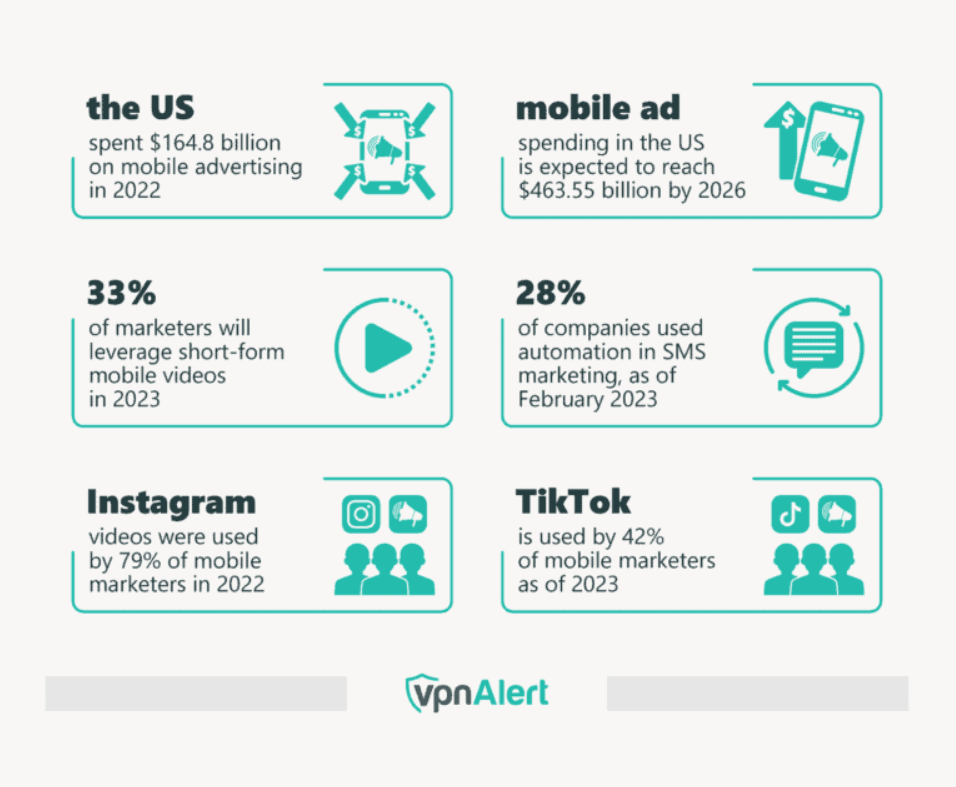Marketers of Earth — we have seen the future! Step with us into a realm of endless growth and unprecedented success, where your business is seamlessly connected to your target audience, captivating their attention and forging personal connections. Where the power to thrive and expand one’s reach lies within the ever-active grasp of each of us. Avert your eyes as you witness the blinding promise of tomorrow, and welcome the new era of marketing today!
Yes, check your pockets — the future is your mobile phone!
Download Free White Paper Now: Everything You Need to Know About Email Marketing
In today’s digital age, mobile devices have become an extension of ourselves. We rely on them for communication, entertainment, and even shopping. It’s no wonder that mobile marketing has become a game-changer for businesses worldwide.
With 57% of Americans considering themselves “addicted” to their phones, it’s clear that mobile devices have become an integral part of our daily routines. In this blog post, we’ll dive into the captivating world of mobile marketing and reveal the tips and techniques you need to prosper in the mobile era.


(Source: VPNAlert)
The Mobile Phenomenon: The Importance of Mobile Marketing
Businesses must adapt to the ever-changing mobile world or risk being left behind. Mobile marketing offers several key advantages for businesses:
- Mobile devices are the primary gateway to the internet: With mobile devices accounting for over 58.33% of global website traffic in Q1 of 2023, optimizing your online presence for mobile is crucial to capture and retain customers.
- Connect with customers anytime, anywhere: Mobile devices offer businesses the unique opportunity to connect with their target audience wherever they are and engage with them on a personal level.
The Importance of Mobile Marketing
One way businesses can remain competitive in today’s market is by investing in mobile marketing strategies that are specifically designed for mobile devices.
Mobile marketing is the practice of promoting products or services to customers through mobile devices such as smartphones and tablets. It includes various techniques such as SMS marketing, mobile-friendly websites, and mobile apps.
Landing Page Optimization
In mobile marketing, the landing page is crucial as it is the first point of contact between the user and the business. Hence, it is essential to optimize the landing page for mobile devices to ensure a seamless user experience.
For every second that it takes a landing/web page to load, the average conversion rate drops by 4.42%. Bounce rates for web pages are already between 41-55%, therefore, a mobile-friendly landing page should have a fast loading speed and mobile-responsive design.


(Source: Portent)
The key elements of a mobile-friendly landing page include a clear and concise headline, a prominent call-to-action button, minimal text, and easy navigation. By optimizing the landing page, businesses can increase their conversion rates and generate successful leads. And thankfully, there’s technology out there to help with that optimization.
With Mirabel’s Marketing Manager, the Landing Page Builder has a Mobile option where you can edit your Landing Page through the mobile view without changing its appearance on the desktop view. By optimizing your landing page for mobile, you can leave a positive and lasting first impression on viewers and effectively begin building relationships with possible leads.
Mobile-Friendly Website and App Optimization
A mobile-friendly website should have a responsive design that adapts to different screen sizes, fast loading speed, and easy navigation.
Similarly, a mobile app should be user-friendly, visually appealing, and offer valuable features. By optimizing the website and app for mobile devices, businesses can enhance their brand image and increase customer loyalty.
Visual appeal in mobile-friendly web and app design can be the deciding factor on whether or not people engage with your content. If your design is unappealing, viewers will leave your app or website immediately. Try and aim for a minimalistic design and do not overcrowd your page with information. Functionality and readability makes your website or app easier to navigate and understand.
Geo-Targeted Advertising
One of the most significant advantages of mobile marketing is the ability to target customers based on their location. Companies can use geo-targeted advertising to deliver location-specific messages to their target audience. Obviously, geo-targeted advertising is only permitted when users select ‘allow permission’ and is only used within specific parameters so as not to infringe on privacy.
When focused specifically on mobile marketing, businesses can use GPS, WiFi signals, and mobile apps that allow location to narrow down their marketing strategies. Companies like Uber, Sephora, and Yelp all use location to specifically target their consumers. They all sold geo-targeted ads within apps, google, and social media sites.
Sephora and Uber both use geo-targeted ads to advertise in areas where there is a Sephora or places where Uber is prevalent. Yelp uses users’ location to give them a highly specific experience and only shows information that is useful for their area. They aren’t the only ones. Countless retail stores and restaurants display ads that are relevant to shoppers in their area. When visiting a place like South Florida, mobile users may begin to see more ads for swimwear, current things to do, and popular bars and restaurants in the area. Particularly with social media apps like Instagram and Facebook, marketers can target their advertisements to those within a particular area.
A few examples of geo-targeted advertising are:
- Localized Offers: Businesses can tailor their advertising campaigns to specific locations, taking into account factors such as local events, cultural nuances, and regional preferences. This approach helps create a more personalized experience for customers and increases the likelihood of conversion.
- Competitor Targeting: Another application of geo-targeted advertising is to target customers who are in proximity to competitor locations. By delivering compelling offers or highlighting unique selling points, businesses can attract customers away from their competitors and towards their own products or services.
- Personalized Recommendations: Geo-targeted advertising can also be used to provide personalized recommendations based on a user’s location. For example, a restaurant app can suggest nearby dining options based on the user’s current location, making it convenient for users to find and explore local establishments.
Social Media Marketing
Social media marketing and email optimization are critical components of mobile marketing. There are over 4.48 billion people that use social media. Out of those people, 99% access social media sites using their mobile device. Therefore, businesses need to optimize their social media and email campaigns for mobile devices. This includes creating mobile-friendly content, using visuals, keeping the message concise, and optimizing the call-to-action. By optimizing social media, businesses can reach a wider audience and increase their brand visibility.
Here are 4 tips for social media growth:
- Post Consistently
Posting frequently will help build engagement and increase the amount of consumers that see your post.
- Make posts short but engaging
People have short attention spans to begin with. On social media where people can endlessly scroll, attention spans are even shorter. By making posts interesting and diversifying their content, marketers can increase their engagement.
- Use Hashtags
Hashtags are great for increasing brand reach and engagement and act like keywords to gain exposure. Just keep in mind that more is not always better and companies should try and use relevant and specific hashtags that apply to their consumer base.
- Be Authentic
Developing a human connection with consumers is the most important strategy of them all. Posting content that is authentic and properly represents your brand connects you with consumers and humanizes your brand.
Email Optimization for Mobile Devices
To optimize email campaigns for mobile devices, marketers should apply the following when drafting emails:
1. Use a Mobile-Friendly Email Template
Using a mobile-friendly email template is the first step to optimize email campaigns for mobile devices. The template should have a responsive design that can adapt to different screen sizes, a clear and concise subject line, a single-column layout, and large fonts. The email content should be short and to the point, with a prominent call-to-action button that is easy to tap on mobile devices.
2. Optimize Images for Mobile Devices
Images are an essential part of email campaigns, but they can also slow down the loading time on mobile devices. To optimize images for mobile devices, businesses should use smaller image file sizes, compress images, and use alt text for images. Additionally, businesses should avoid using too many images in their email campaigns and only use images that are relevant to the email content.
It is important to ensure that images are laid out properly in the mobile format because they tend to stack incorrectly. Mirabel’s Marketing Manager has a Do Not Stack On Mobile feature to ensure that your layout is maintained on mobile.
3. Keep the Email Content Concise
Mobile users have a shorter attention span compared to desktop users, so it is essential to keep the email content concise and to the point. Businesses should avoid using long paragraphs and use bullet points and subheadings to break up the text. Moreover, the email content should be scannable, with the most important information at the top.
4. Test the Email Campaigns on Mobile Devices
Before sending out email campaigns, businesses should test the emails on different mobile devices to ensure that they are optimized for mobile devices. Testing the email campaigns on different devices can help identify any issues with the email design, loading time, and formatting.
Businesses could use A/B testing to see which subject line and email body performs better on mobile. Mirabel’s Marketing Manager has the capability of doing this and giving you analytics to compare how each campaign did.
SMS Marketing
SMS marketing is a highly effective mobile marketing strategy that involves sending promotional messages to customers’ phones. As stated in SMS comparison, the open rate for SMS messages is 98%, compared to 20% for emails.
SMS marketing can be used to promote new products, special offers, and upcoming events. The key to successful SMS marketing is to keep the message short and sweet, offer value to the customer, and include a clear call-to-action. By using SMS marketing, businesses can increase customer engagement and generate leads.
However, businesses must be careful when using SMS marketing. SMS has reached its saturation point, with consumers beginning to show signs of SMS fatigue. In a study done by Arion Research, they found that within the last 12 months, consumers’ attitudes towards SMS have drastically changed. 34% of people in the study report that they receive more unwanted/spam SMS messages and 19% now block more businesses through SMS. Only 11% of people actually prefer SMS as a way to connect with businesses. The overwhelming flood of SMS is driving people away rather than creating more business.
A recipient’s age is a huge factor on whether or not they block SMS advertisements. Only 12% of Baby Boomers said that companies sent too many SMS messages, whereas 32% of Millenials agreed.
Based on these statistics, it is safe to say that when using SMS marketing strategies, targeting older demographics of people such as Generation X and Baby Boomers would be safer and more effective.
How Mobile Marketing Can Benefit Your Business
Mobile marketing allows businesses to reach their target audience anytime and anywhere. This means that businesses can connect with their customers on a more personal level and build lasting relationships with them.
Secondly, mobile marketing is cost-effective and offers a high return on investment. SMS marketing, for example, offers a higher open rate than email marketing and can be a more cost-effective way to reach customers. Finally, mobile marketing allows businesses to track their marketing campaigns in real-time, which means that they can make data-driven decisions to improve their marketing efforts.
Mobile marketing is a vital strategy for businesses to reach their target audience and generate leads. By optimizing landing pages, websites, apps, social media, email campaigns, and using SMS marketing, businesses can increase their brand visibility, enhance customer engagement, and generate leads. As mobile devices continue to dominate the digital landscape, businesses must invest in mobile marketing to remain competitive and relevant in today’s market.
For more information about how to improve your email deliverability, download A Beginner’s Guide to Email Marketing by Mirabel’s Marketing Manager:
SEE FOR YOURSELF
Watch an overview to learn how B2B marketing automation by Mirabel Technologies can help you increase traffic, optimize your funnel, drive more leads, improve conversions, and boost ROI — at a price you can afford!




